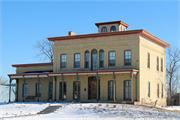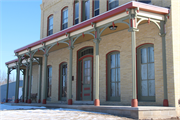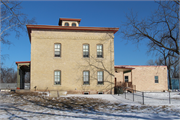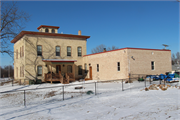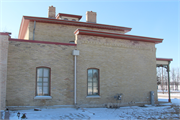Property Record
970 S MONROE ST
Architecture and History Inventory
| Historic Name: | Henry and Barbara Bierbauer House |
|---|---|
| Other Name: | |
| Contributing: | |
| Reference Number: | 120631 |
| Location (Address): | 970 S MONROE ST |
|---|---|
| County: | Juneau |
| City: | New Lisbon |
| Township/Village: | |
| Unincorporated Community: | |
| Town: | |
| Range: | |
| Direction: | |
| Section: | |
| Quarter Section: | |
| Quarter/Quarter Section: |
| Year Built: | 1869 |
|---|---|
| Additions: | |
| Survey Date: | 197420112014 |
| Historic Use: | house |
| Architectural Style: | Italianate |
| Structural System: | |
| Wall Material: | Brick |
| Architect: | |
| Other Buildings On Site: | |
| Demolished?: | No |
| Demolished Date: |
| National/State Register Listing Name: | Bierbauer, Henry and Barbara, House |
|---|---|
| National Register Listing Date: | 6/14/2016 |
| State Register Listing Date: | 2/19/2016 |
| National Register Multiple Property Name: |
| Additional Information: | A 'site file' exists for this property. It contains additional information such as correspondence, newspaper clippings, or historical information. It is a public record and may be viewed in person at the Wisconsin Historical Society, Division of Historic Preservation-Public History. 2015- "The Bierbauer House is located at 970 South Monroe Street in the city of New Lisbon, immediately north of the junction of the Canadian Pacific and Canadian National Railways. It is situated on a slight rise near the center of a polygonal parcel that contains few trees and other landscape features. A walkway provides access to the front of the house from South Monroe Street and a driveway runs along the north parcel line. The rear, southeast corner of the property is enclosed by a chain-link fence. The Bierbauer House is a two-story ltalianate residence erected in 1869 for Henry Bierbauer, the founder and proprietor of the New Lisbon Brewery. The brewery complex (nonextant) was located immediately to the north, which is now occupied by modern industrial buildings. The Bierbauer House has a square footprint, raised stone foundation, cream-brick exterior, and flat roof with wide boxed eaves, central cupola, and pair of brick chimneys. The front (west) facade is symmetrical and five bays wide. The center bay features a large segmental arch entryway with a wood panel door, side lights, and arched transom with a brick hoodmold. Above the door on the second story is a grouping of three round-arch openings with brick hoodmolds. The larger, center opening contains a French door, while each outer opening is fitted with a six-light, hinged wood casement window. The outer four bays of the facade are identical, each consisting of a tall, segmental arch, six-light, hinged wood casement window on the first story that extends to the floor and a segmental arch, six-light, hinged wood casement window with a stone sill on the second story. The windows feature brick segmental arch hoodmolds. The facade is highlighted by a full-width flat-roof porch supported by wood posts resting on a concrete block foundation. It is embellished with arched brackets and other decorative wood details. Other ornamentation on the facade includes corner brick pilasters and brick corbeling above the second-story windows. The brick corbelling and pilasters are also present on the secondary elevations. The square cupola is clad in fiberboard and features a pair of round arch wood casement windows on each elevation and decorative scroll brackets beneath the eaves at the corners. Attached to the north side of the house is a one-story wing that appears to date from the original period of construction. It has identical architectural details as the primary mass of the building. Its front elevation includes a segmental arch door and pair of segmental arch, six-light wood casement windows with stone sills and brick hoodmolds. The wing also shares the same elaborate porch and ornamental brick corbeling and pilasters, and a parapet was utilized to add height to the structure. The north (side) elevation of the wing contains a pair of segmental arch, six-light wood casement windows. The south (side) elevation of the house contains six segmental arch, six-light wood casement windows, three on each floor. The window openings are similar to those on the facade and have brick hood molds and stone sills. A basement bulkhead door is located on this side of the house. The east (rear) elevation contains seven of the same segmental arch casement windows, three on the first floor and four on the second. A fourth opening on the first floor is for a segmental arch door. The secondary entrance includes a central modern wood porch with a shed roof. There is a wide unadorned space above the pilaster caps and corbeling and beneath the eaves, and the brick appears to have a different texture than on the rest of the house. Although it appears that original details may have been removed or the roofline altered, after careful review of historic photographs and a discussion with the property owners, this seems unlikely. The wide space between the corbeling and eaves is apparent in undated historic photographs, and the owners indicated that they worked with a mason during the restoration work and concluded that exterior features, such as a wide frieze board, were likely not present historically. A single-story, two-car, flat-roof garage was added to the rear of the wing between 2011 and 2013, replacing a small, frame lean-to that housed a cistern. The garage is constructed of cream brick, similar in appearance to what was used for the rest of the house, and includes similar brick corbelling. Two overhead doors and a pedestrian door are located on the north (side) elevation. One-over-one vinyl windows are positioned on the east (rear) and south (side) elevations. The interior layout is a standard center hall plan (floor plans of the building are provided as attachments). The first floor of the main portion of the house is three rooms wide (which includes the hall) and two rooms deep. The center hall includes the staircase, which faces the entry foyer and features an elaborate wood newel post and turned wood balusters. The rooms include a parlor, two dining rooms, and a kitchen, which accesses the garage addition. The one-story wing attached to the north side of the house contains a study, bathroom, and living room. The second floor has four bedrooms, one at each corner of the building, and a bathroom. The staircase leads from the second floor past a doorway and into the cupola. The stair railing extends into the cupola and encircles the small space. Just beneath the cupola is a doorway leading to an attic. The interior walls of the cupola are clad with drop wood siding. Original interior details throughout the house include wood floors, wide baseboards and trimwork, crown molding, and pocket doors. Certain rooms were modernized, including the kitchen, bathrooms, and living room. Restoration The Bierbauer House was recently restored by the current owners, who acquired the property in 2011, after the National Register Nomination questionnaire was submitted to the SHPO. Based on a historic photograph of the property, the restoration project was sensitive to the historic fabric of the building and largely returned it to its historic appearance. The house had fallen into disrepair, and as a result certain architectural features had to be recreated in-kind by a carpenter, such as portions of the decorative porch details and sections of the roofline fascia. Most of the porch was able to be saved and restored, with much of the work limited to the wing section. In addition, the frame base was reconstructed using concrete block. The building's brick exterior, which was painted at some point, was sandblasted and subsequently re-painted with the appropriate type and color of mortar. The cupola was re-sided with fiberboard that has a similar appearance and dimensions as the original wood siding. None of the wood windows have been replaced, but storm windows were added to the second floor. Two additions were constructed: the garage and small rear porch. They are compatible with the design of the house and largely concealed from view of the public, and therefore do not diminish the building's ability to convey its architectural significance. The interior of the house retains the center hall plan and many of the original features and finishes, such as the elaborate wood staircase, wood floors, wood baseboards and trimwork, crown molding, and pocket doors. The staircase between the first and second floor had been replaced with a wider staircase in the 1950s, during a brief period when the building was used as a nursing home. The original staircase was disassembled and saved, however, so it was able to be rebuilt. As noted, the kitchen, bathrooms, and living room were modernized." -"Henry and Barbara Bierbauer House", WisDOT 5530-03-01, Prepared by Mead & Hunt, Inc. (2015). Resurveyed December 2011; alterations include the repair of all exterior brickwork, the refinishing of the cupola, and repair of original windows and window frames October 2014: An attached two-car garage was added at the rear (northeast) corner of the property in 2014, which utilizes sympathetic materials and architectural details. |
|---|---|
| Bibliographic References: |
| Wisconsin Architecture and History Inventory, State Historic Preservation Office, Wisconsin Historical Society, Madison, Wisconsin |

